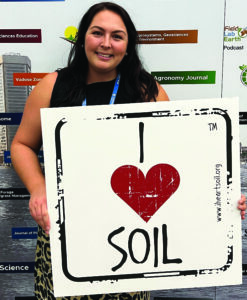Soil characteristics important to carbon storage potential
KEY RESULT:
Previous work showed that crop yields are higher in the diverse rotations, but when it comes to increasing soil organic matter and carbon storage, this study showed no consistent crop rotation effect.
PROJECT TITLE, PRINCIPAL INVESTIGATOR:
“Understanding the effects of crop rotation on soil organic carbon stabilization,” Bobbi L. Helgason, University of Saskatchewan
FUNDING:
SaskCanola
PUBLISHED ARTICLES:
Read the full report on the Canola Research Hub.
Soil organic matter (SOM) is a cornerstone of soil health and sustained soil productivity. However, not all SOM is created equal when it comes to carbon storage.
Particulate organic matter is one of the two major types of SOM. This is basically pieces of partially decomposed plant material, which are more easily destabilized through microbial decay. Carbon stored in particulate matter is more susceptible to turnover and future loss through biological processes like nitrogen transformations, unless it gets protected by stable soil aggregates.
Mineral-associated organic matter, the other major form of SOM, is more stable. To increase long-term carbon storage in soil, we need to move more plant material into this mineral-associated pool.
With this study, researchers hoped to provide evidence-based guidance – especially with regard to crop rotation – for improvements to soil organic carbon (SOC) stabilization. They examined archived soils from three different long-term cropping trials to assess the impact of crop rotations on soil carbon. Archived data were from canola and wheat rotation studies at Lacombe, Alberta, Scott, Saskatchewan and Swift Current, Saskatchewan.
Not surprising, the clay loam soils at Lacombe had more SOM and SOC than the loamy textured soils at Scott and Swift Current. However, results did not point to any specific recommendations on rotation to increase stored carbon in the soil.
The lack of consistent differences in carbon pools observed under different canola cropping frequencies indicates that the interplay between quantity and quality of crop root and residue inputs – canola, wheat, barley and field peas – did not lead to differences in carbon stabilization in these systems.

Canola, wheat, barley and field peas have different above- and below-ground biomass both in quantity and quality. Previous studies proposed that the proportionally higher below-ground carbon deposition by canola can contribute to increasing soil organic carbon stocks. However, this project demonstrated that mineral-associated organic matter and particulate organic matter pools were not affected by long-term continuous mono-cropping versus diverse crop rotations in the wheat and canola systems studied.
Previous work showed that crop yields are higher in the diverse rotations, but when it comes to increasing soil organic matter and carbon storage, this study showed no consistent crop rotation effect on the size of the two carbon pools.
Researchers concluded that long-term quantity or partitioning of mineral-associated organic matter and particulate organic matter pools in the Prairie annual cropping systems studied here may be determined more strongly by intrinsic soil properties. Quantity and quality of organic matter inputs, as driven by crop rotation decisions, seem to play a secondary role.
The benefit of crop rotation – “organic matter inputs” – on the Prairies could be more accurately measured with a change in methodology, the researchers conclude. For this study, they sampled at peak flowering in the canola systems which may not be ideal for detecting the long-term interactions of microbial abundance and carbon pools. It is recommended that future studies studying these relationships sample in fall after harvest or in early spring before the crop is planted.





